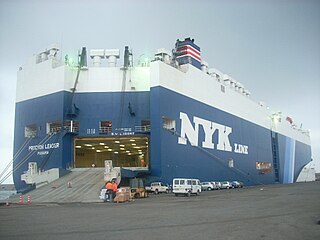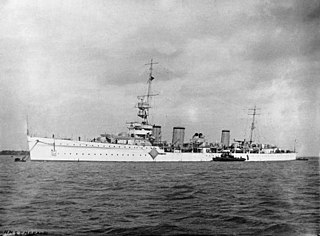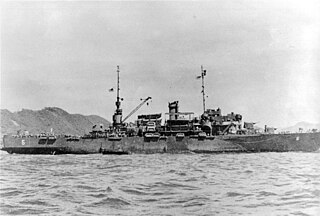
A dock landing ship is an amphibious warfare ship with a well dock to transport and launch landing craft and amphibious vehicles. Some ships with well decks, such as the Soviet Ivan Rogov class, also have bow doors to enable them to deliver vehicles directly onto a beach. Modern dock landing ships also operate helicopters.

The landing craft, tank (LCT) was an amphibious assault craft for landing tanks on beachheads. They were initially developed by the Royal Navy and later by the United States Navy during World War II in a series of versions. Initially known as the "tank landing craft" (TLC) by the British, they later adopted the U.S. nomenclature "landing craft, tank" (LCT). The United States continued to build LCTs post-war, and used them under different designations in the Korean and Vietnam Wars.

Landing Ship, Tank (LST), or tank landing ship, is the naval designation for ships first developed during World War II (1939–1945) to support amphibious operations by carrying tanks, vehicles, cargo, and landing troops directly onto a low slope beach with no docks or piers. The shallow draft and bow doors and ramps enabled amphibious assaults on almost any beach.

USS Oglala (ID-1255/CM-4/ARG-1) was a minelayer in the United States Navy. Commissioned as Massachusetts, she was renamed Shawmut a month later, and in 1928, was renamed after the Oglala, a sub-tribe of the Lakota, residing in the Black Hills of South Dakota.

Aquila was an Italian aircraft carrier converted from the transatlantic passenger liner SS Roma. During World War II, Work on Aquila began in late 1941 at the Ansaldo shipyard in Genoa and continued for the next two years. With the signing of the Italian armistice on 8 September 1943, however, all work was halted and the vessel remained unfinished. She was captured by the National Republican Navy of the Italian Social Republic and the German occupation forces in 1943, but in 1945 she was partially sunk by a commando attack of Mariassalto, an Italian royalist assault unit of the Co-Belligerent Navy of the Kingdom of Italy, made up by members of the former Decima Flottiglia MAS. Aquila was eventually refloated and scrapped in 1952.

Roll-on/roll-off ships are cargo ships designed to carry wheeled cargo, such as cars, motorcycles, trucks, semi-trailer trucks, buses, trailers, and railroad cars, that are driven on and off the ship on their own wheels or using a platform vehicle, such as a self-propelled modular transporter. This is in contrast to lift-on/lift-off (LoLo) vessels, which use a crane to load and unload cargo.

Richborough is a settlement north of Sandwich on the east coast of the county of Kent, England. Richborough lies close to the Isle of Thanet. The population of the settlement is included in the civil parish of Ash.

HMS Emerald was an Emerald-class light cruiser of the Royal Navy. She was built by Armstrong at Newcastle-on-Tyne, with the keel being laid down on 23 September 1918. She was launched on 19 May 1920 and commissioned 14 January 1926.

USS Sable (IX-81) was a United States Navy training ship during World War II, originally built as the passenger ship Greater Buffalo, a sidewheel excursion steamboat. She was purchased by the Navy in 1942 and converted to a training aircraft carrier to be used on the Great Lakes. She lacked a hangar deck, elevators, or armament and was not a true warship, but she provided advanced training of naval aviators in carrier takeoffs and landings.

HMS Pegasus was an aircraft carrier/seaplane carrier bought by the Royal Navy in 1917 during the First World War. She was laid down in 1914 by John Brown & Company of Clydebank, Scotland as Stockholm for the Great Eastern Railway Company, but construction was suspended at the start of the war. The ship was converted to operate a mix of wheeled aircraft from her forward flying-off deck and floatplanes that were lowered into the water. Pegasus spent the last year of the war supporting the Grand Fleet in the North Sea, but saw no combat. She spent most of 1919 and 1920 supporting British intervention against the Bolsheviks in North Russia and the Black Sea. The ship remained with the Mediterranean Fleet until 1924, but was placed in reserve in 1925 after a brief deployment to Singapore. Pegasus was sold for scrap in 1931.

USS Prairie (AD-5), formerly Morgan Liner SS El Sol, was built in 1890 by William Cramp & Sons, Philadelphia. She was purchased by the United States Navy on 6 April 1898 from the Southern Pacific Company, and commissioned two days later at New York, Commander Charles J. Train in command.

HMS Adventure, pennant number M23, was an Adventure-class minelaying cruiser of the Royal Navy built in the 1920s that saw service during the Second World War. Her commander between 1928 and 1929 was the future First Sea Lord John H. D. Cunningham. Laid down at Devonport in November 1922 and launched in June 1924, Adventure was the first vessel built for service as a minelayer; she was also the first warship to use diesel engines, which were used for cruising. Adventure first joined the Atlantic Fleet, then was transferred to the China Station in 1935. In World War II, the ship was damaged in 1941 and 1944, and was converted to a landing craft repair in 1944. In 1945 Adventure was reduced to reserve and in 1947 she was sold and broken up for scrap.

USS Monitor (LSV-5/AN-1/AP-160/MCS-5) was an Osage-class vehicle landing ship built for the United States Navy during World War II. She was named after the original USS Monitor, and was the second U.S. Naval vessel to bear the name.

USS Arctic (AF-7) was an Arctic-class stores ship acquired by the United States Navy shortly after World War I, which saw extensive service in World War II. She served in the Pacific Ocean, delivering food and household items to ships and bases.

The steamboat Daily operated in the early 1900s as part of the Puget Sound Mosquito Fleet. In later years, Daily was renamed Island Princess and later Cy Peck.

The Duke of York was a steamer passenger ship initially operated by the London Midland and Scottish Railway which saw service from 1935 to 1964. She was renamed HMS Duke of Wellington for the duration of World War II.
TSS Train Ferry No. 2 was a freight vessel built for the British Army War Office in 1917.

TSS Train Ferry No. 3 was a roll on/roll off freight vessel built for the British War Office in 1917.

The Dover–Dunkerque train ferry was one of two regular rail freight train ferries that operated between the United Kingdom and Europe. The route connected the English port of Dover, with the French port of Dunkerque. After rationalisation of other Anglo-European train ferries, the Dover to Dunkerque sailing was the last to survive, though it ended its days on freight carryings only after the Night Ferry passenger service ended in 1980. The last Dover to Dunkerque wagon-freight ferry service became redundant upon the opening of the Channel Tunnel when freight was carried directly through the Channel Tunnel.

MS Europic Ferry was a roll-on/roll-off car ferry built in 1967 by Swan Hunter for the Atlantic Steam Navigation Company (ASN). She was acquired by European Ferries in 1971 when they took over the ASN and served with them under the Townsend Thoresen branding. The Europic Ferry was requisitioned by the British government in April 1982 and transported stores, equipment and troops to the South Atlantic during the Falklands War. After the war she returned to service with European Ferries until that company was sold to P&O in 1987. She was sold again to Namora Shipping in 1993 and served on routes in the Mediterranean until sold for scrapping in 2004.



















